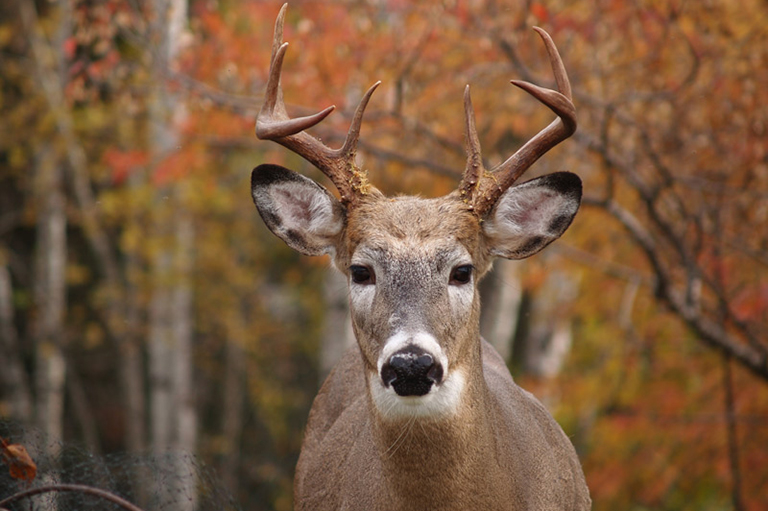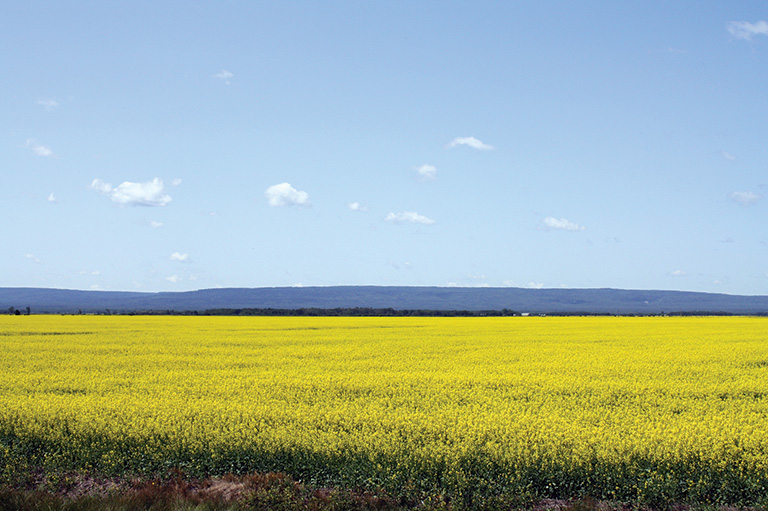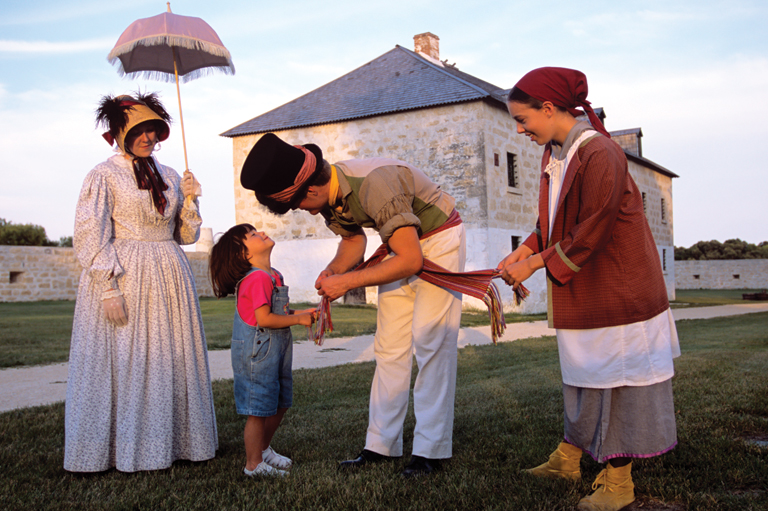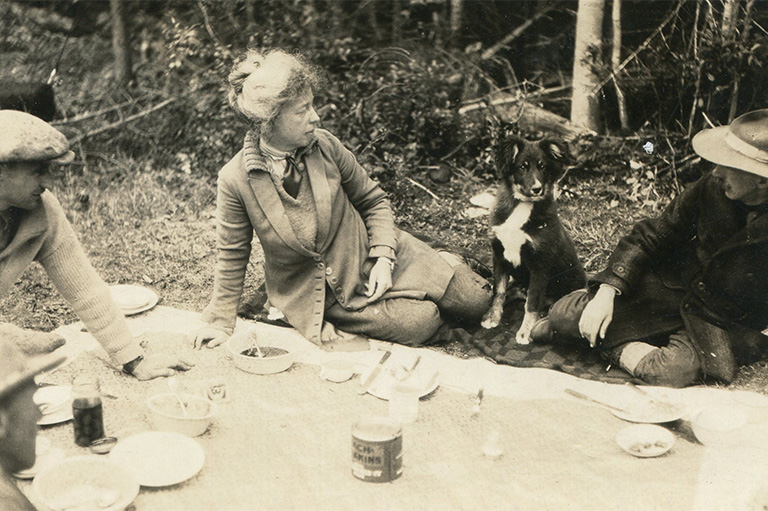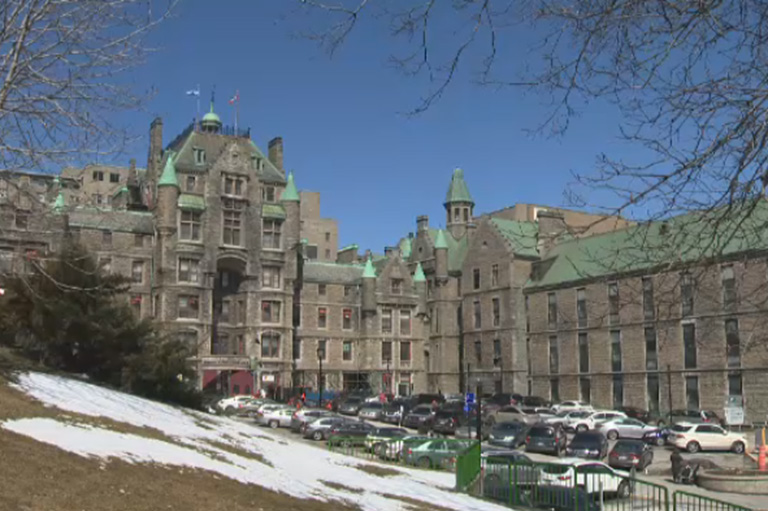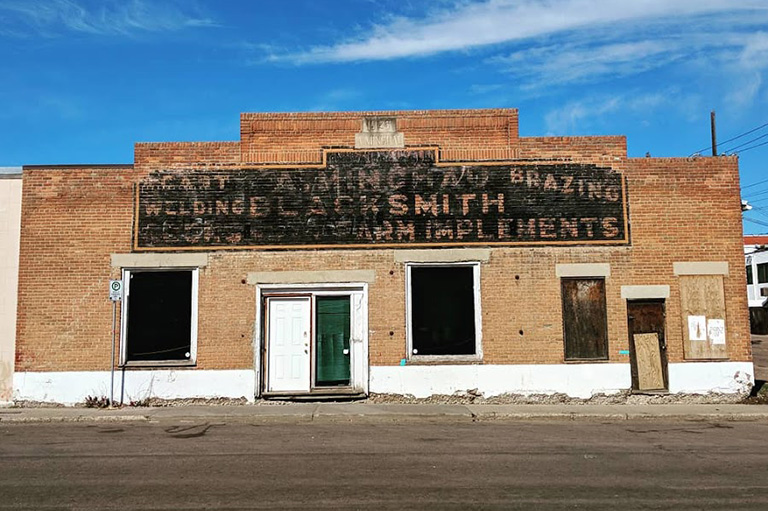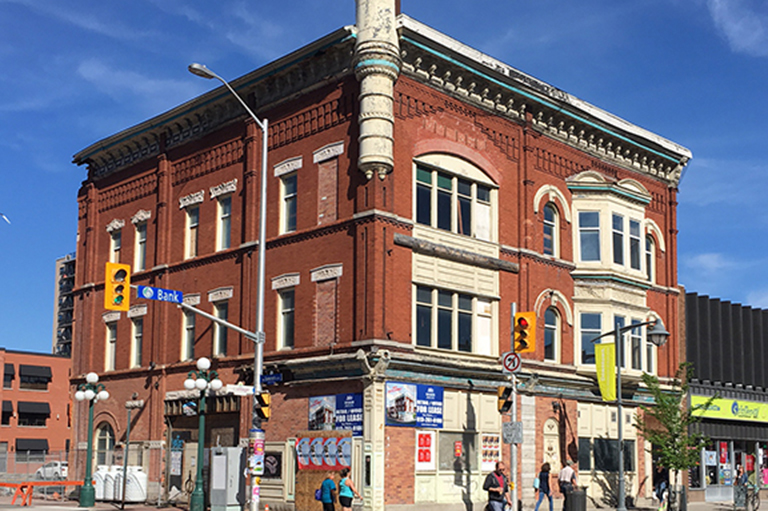Trading Places
-
 The image of a Red River cart is part of the illuminated Heritage Wall at Upper Fort Garry in Winnipeg, while the Fort Garry Hotel is beyond the wall, at the right.Photo by Phil Koch
The image of a Red River cart is part of the illuminated Heritage Wall at Upper Fort Garry in Winnipeg, while the Fort Garry Hotel is beyond the wall, at the right.Photo by Phil Koch -
 The 1853 stone north gate is the only remaining part of Upper Fort Garry.Photo by Phil Koch
The 1853 stone north gate is the only remaining part of Upper Fort Garry.Photo by Phil Koch -
 Hudson’s Bay House on Winnipeg’s Main Street circa 1931.The Beaver June 1931
Hudson’s Bay House on Winnipeg’s Main Street circa 1931.The Beaver June 1931 -
 A hallway in Hudson’s Bay House displays photographs from The Beaver magazine circa 1944.The Beaver March 1944
A hallway in Hudson’s Bay House displays photographs from The Beaver magazine circa 1944.The Beaver March 1944 -
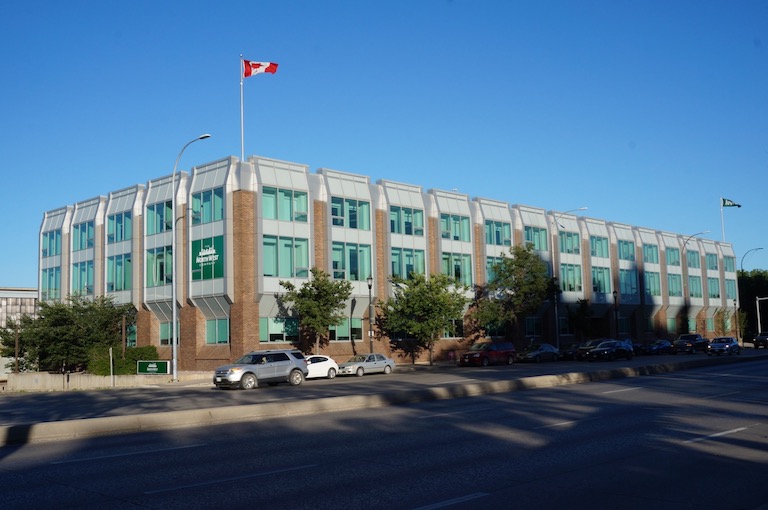 The former Hudson’s Bay House is today known as Gibraltar House and is the headquarters of the revived North West Company.Photo by Phil Koch
The former Hudson’s Bay House is today known as Gibraltar House and is the headquarters of the revived North West Company.Photo by Phil Koch -
 The beaux arts Union Station is a National Historic Site that continues to serve as Winnipeg’s passenger railway hub.Photo by Phil Koch
The beaux arts Union Station is a National Historic Site that continues to serve as Winnipeg’s passenger railway hub.Photo by Phil Koch -
 The Canadian Museum for Human Rights is the first national museum built outside the National Capital Region.Photo by Phil Koch
The Canadian Museum for Human Rights is the first national museum built outside the National Capital Region.Photo by Phil Koch -
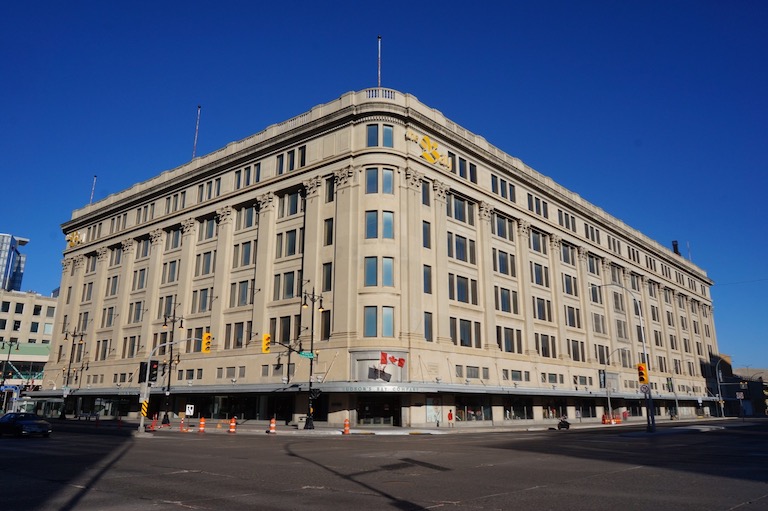 The Hudson’s Bay Company’s grand store at the corner of Portage Avenue and Memorial Boulevard opened in 1926.Photo by Phil Koch
The Hudson’s Bay Company’s grand store at the corner of Portage Avenue and Memorial Boulevard opened in 1926.Photo by Phil Koch -
 A sign adorns a corner of the Bay store in downtown Winnipeg.Photo by Phil Koch
A sign adorns a corner of the Bay store in downtown Winnipeg.Photo by Phil Koch -
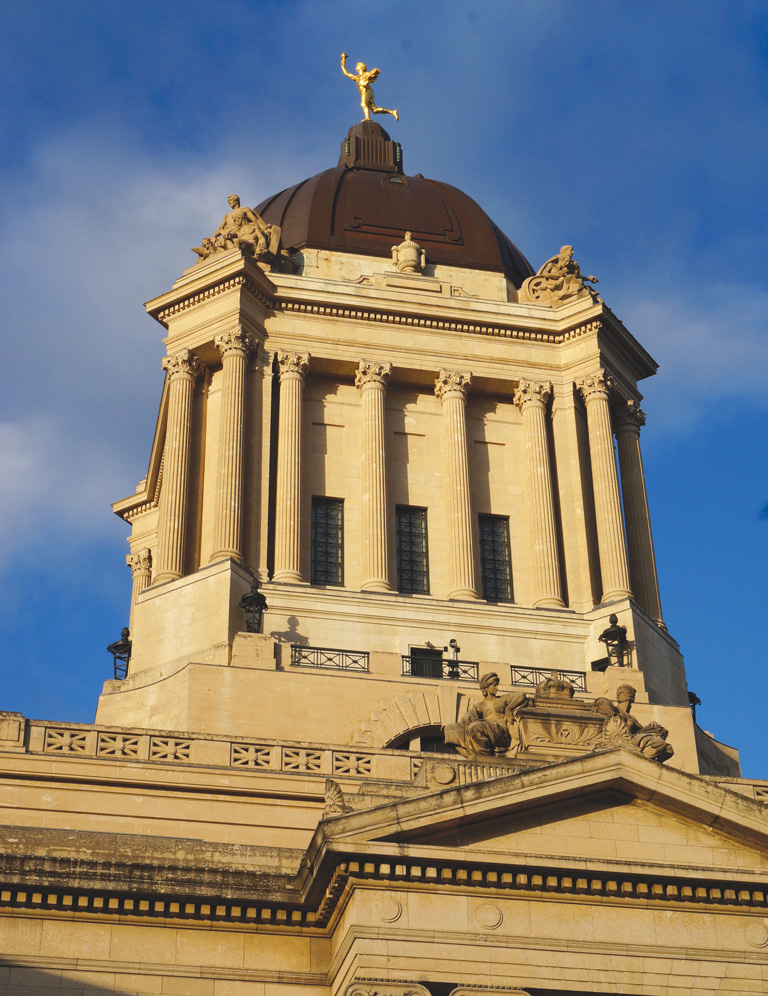 The Manitoba Legislative Building is adorned with numerous sculptures and is topped by the Golden Boy statue.Photo by Phil Koch
The Manitoba Legislative Building is adorned with numerous sculptures and is topped by the Golden Boy statue.Photo by Phil Koch -
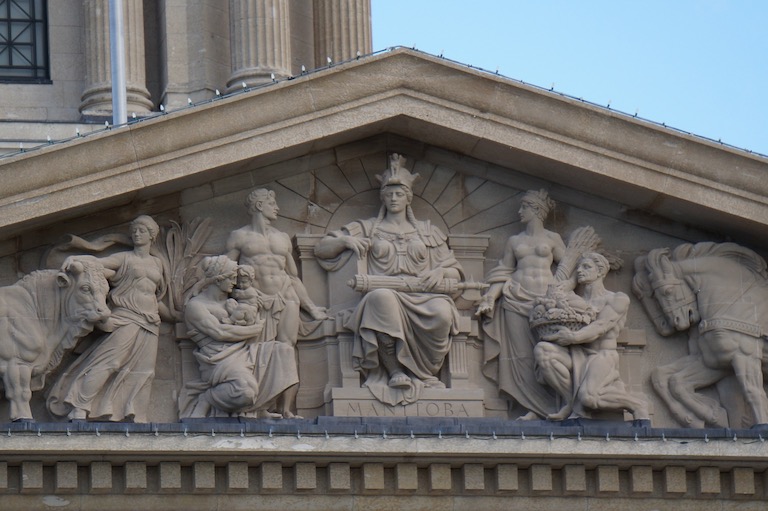 The main pediment of the Manitoba Legislative Building signifies the ideals of tolerance, justice, and hard work and features a central female figure representing Manitoba.Photo by Phil Koch
The main pediment of the Manitoba Legislative Building signifies the ideals of tolerance, justice, and hard work and features a central female figure representing Manitoba.Photo by Phil Koch -
 The Golden Boy statue atop the Manitoba Legislative Building was modelled on a sculpture of Mercury, the Roman god of trade and commerce.Photo by Phil Koch
The Golden Boy statue atop the Manitoba Legislative Building was modelled on a sculpture of Mercury, the Roman god of trade and commerce.Photo by Phil Koch -
 Century-old buildings at Main Street and Lombard Avenue in Winnipeg’s Exchange District.Photo by Phil Koch
Century-old buildings at Main Street and Lombard Avenue in Winnipeg’s Exchange District.Photo by Phil Koch -
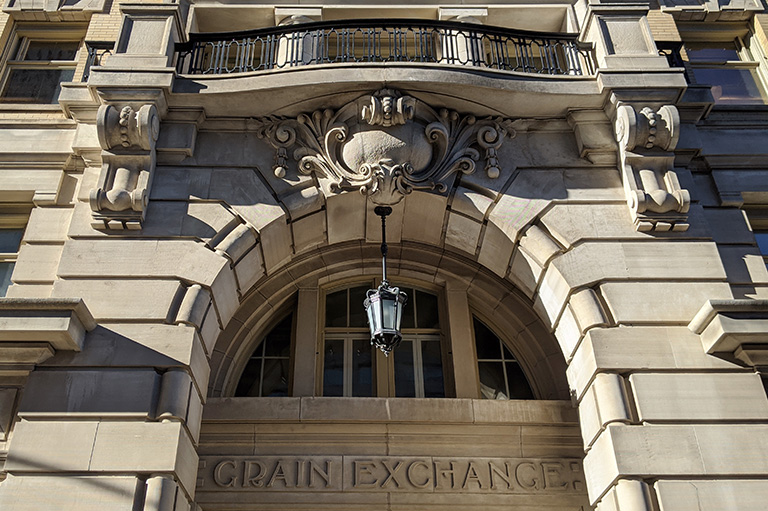 An arch and balcony above the entrance to the Grain Exchange Building on Lombard Avenue.Photo by Phil Koch
An arch and balcony above the entrance to the Grain Exchange Building on Lombard Avenue.Photo by Phil Koch -
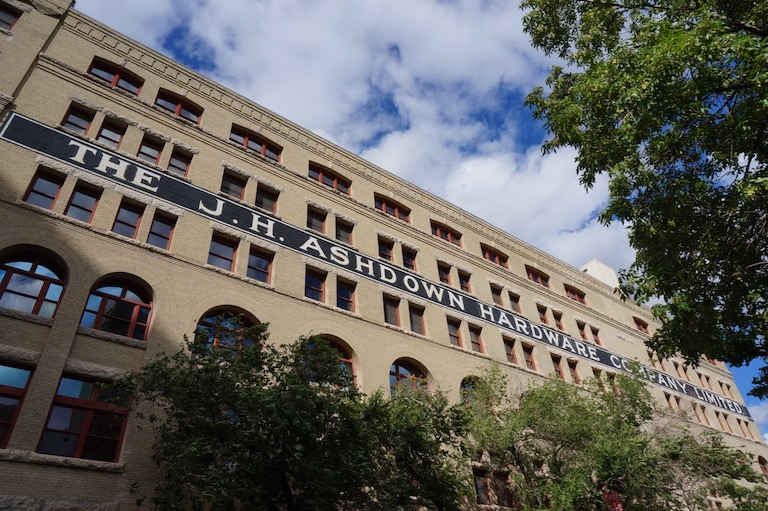 The Ashdown Warehouse, one of the largest in Winnipeg’s Exchange District, has been converted to condominiums and retail space.Photo by Phil Koch
The Ashdown Warehouse, one of the largest in Winnipeg’s Exchange District, has been converted to condominiums and retail space.Photo by Phil Koch -
 Painted advertisements adorn a building on Albert Street in Winnipeg’s Exchange District.Photo by Phil Koch
Painted advertisements adorn a building on Albert Street in Winnipeg’s Exchange District.Photo by Phil Koch -
 The monument Marquee 1919 at the corner of Lily Street and Market Avenue commemorates the Winnipeg General Strike.Photo by Phil Koch
The monument Marquee 1919 at the corner of Lily Street and Market Avenue commemorates the Winnipeg General Strike.Photo by Phil Koch -
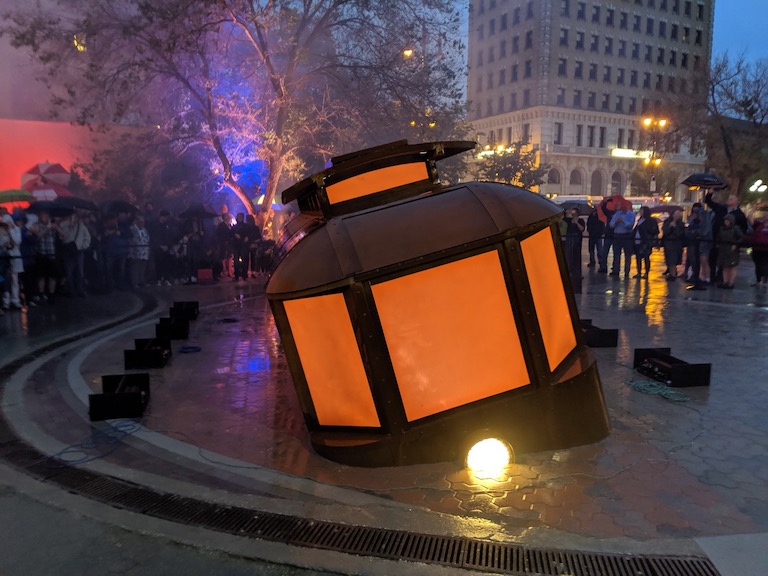 The sculpture Bloody Saturday was unveiled on June 21, 2019, the one hundredth anniversary of a major confrontation during the Winnipeg General Strike.Photo by Phil Koch
The sculpture Bloody Saturday was unveiled on June 21, 2019, the one hundredth anniversary of a major confrontation during the Winnipeg General Strike.Photo by Phil Koch -
 A stained glass window in the University of Winnipeg’s Bryce Hall reflects its time as a theology school.Photo by Phil Koch
A stained glass window in the University of Winnipeg’s Bryce Hall reflects its time as a theology school.Photo by Phil Koch -
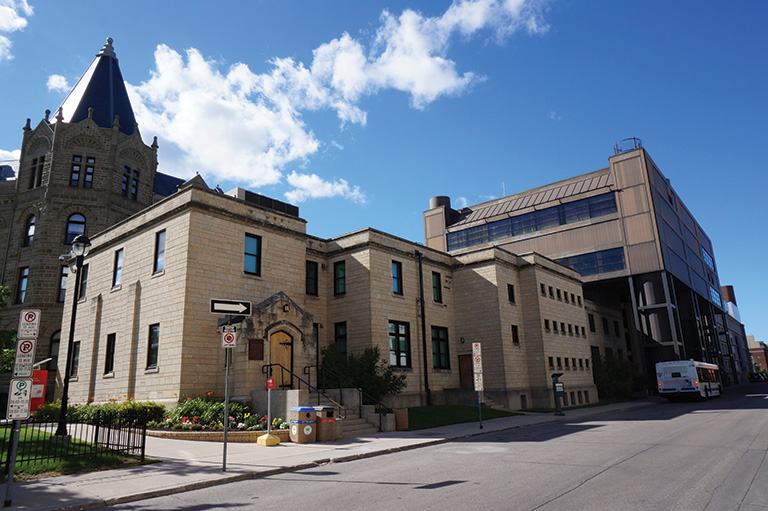 Bryce Hall (foreground) tucks beneath the University of Winnipeg’s Centennial Hall (far right).Photo by Phil Koch
Bryce Hall (foreground) tucks beneath the University of Winnipeg’s Centennial Hall (far right).Photo by Phil Koch
In its first century, The Beaver has occupied important buildings in the most historically significant parts of Winnipeg’s downtown. Like the large fort that predated the modern city, the magazine now known as Canada’s History was founded by the Hudson’s Bay Company near the junction of the Red and Assiniboine rivers. Yet the area was a place for gathering and exchange by Indigenous peoples such as the Cree, Ojibway, Ininew, Anisininew, Assiniboine, and Dakota long before European explorers and traders ventured into the region, and Upper Fort Garry, established in the 1830s, wasn’t the first European fort or even the HBC’s first trading post near the confluence of the two large rivers.
By the time the HBC launched the magazine in 1920, the fort had been demolished to allow the straightening of south Main Street, but the company still operated several nearby buildings. Those included its 1881 retail store at the corner of Main Street and York Avenue, offices in the former Adanac Club at 208 Main, and the Hudson’s Bay House building at 79 Main.
In its first three years The Beaver listed each of those addresses as its own, with Hudson’s Bay House becoming its home by 1923. Built along the railway tracks in 1910–11 south of the new Union Station, the state-of-the-art facility eventually contained not only the company’s Canadian headquarters but also its Fur Trade Depot, its Land Department, and the Wholesale Department that sold Fort Garry tea and coffee — the latter roasted and packaged onsite — as well as point blankets and many other items. Large reproductions of photos from the magazine graced its mahogany-panelled hallways along with life-sized oil paintings of Lord Nelson and Sir George Simpson plus huge maps showing the location of every HBC post and retail store. Since renamed Gibraltar House — after the original North West Company’s first fort in the area — the building is now home to the revived NWC that was spun off from the HBC in 1987.
The modernized building’s southwest corner covers part of the former Upper Fort Garry site, much of which is now a provincial park directly across Main Street. The fort was seized in 1869 by the Métis — who then made up most of the area’s population — and it housed Louis Riel’s provisional government that negotiated with Canada before the Legislative Assembly of Assiniboia decided to join Confederation. (Manitoba became a province on July 15, 1870, and Treaty One, which includes present-day Winnipeg, was agreed in 1871.) While only the 1853 north gate remains, stone plinths mark the locations of key buildings, and the 134-metre weathered-steel Heritage Wall uses sound, light, and inscribed images to tell the story of Indigenous peoples, the fur trade, and the development of Winnipeg and northern Manitoba.
Next to the park are the château-style Fort Garry Hotel and the Manitoba Club. Walking trails along the Assiniboine, south of the park, pass under the CN Railway’s main line and reach The Forks, which is one of the city’s most popular gathering spots. Trading now takes place largely in the form of shopping and dining at dozens of stalls and shops within the Forks Market (formerly stables) and Johnston Terminal (originally a warehouse). Replacing rail yards on what was once known as the Hudson’s Bay flats, The Forks National Historic Site offers views across the Red River to the St. Boniface Cathedral and the cemetery containing Riel’s grave. Other places to visit at or adjacent to The Forks include the Oodena Celebration Circle — which marks the area’s Indigenous cultural history dating back thousands of years — as well as the Manitoba Children’s Museum, the Winnipeg Railway Museum, and the Canadian Museum for Human Rights. Housed in a spectacular contemporary building, the CMHR is the first national museum built outside the National Capital Region.
* * *
Relatively few Winnipeggers know that much of the city’s downtown sits on land once granted for the HBC’s exclusive use and that was sold off in stages. In 1926, with Portage Avenue having become the prosperous city’s main shopping district, the company opened its grand new retail store at the northwest edge of the former HBC reserve, where Colony Creek previously crossed the Portage Trail. It wasn’t until 1987 that The Beaver followed to the impressive six-storey building that fills two city blocks and continues to serve as the downtown Hudson’s Bay store, although now only on two floors. Historical murals that were above the elevator doors on the main floor have been donated to the Manitoba Museum’s HBC Collection, and the top-floor Paddlewheel restaurant (with a rotating replica paddlewheel) and basement Malt Stop (decorated in 1970s orange and brown) have been closed.
The company’s decision regarding the store’s precise location determined the path of Memorial Boulevard, which commemorates citizens of Winnipeg who gave their lives during the First World War and runs south from the store to the beaux-arts neoclassical 1920 Manitoba Legislative Building. Topped by a copper-panelled dome and the northward-facing Golden Boy statue — symbolic of youth and the spirit of enterprise and modelled on a sculpture of Mercury, the Roman god of trade, travel, and communication — the building is tremendously large and opulently detailed inside and out. You can learn about the symbolism of Egyptian sphinxes, Greek gods and goddesses, Masonic numerology, and other intriguing elements of the building with a free guided tour offered by legislature staff or the Hermetic Code tours led by author Frank Albo.
Across Memorial Boulevard from the Bay (as many still know the store) is the Winnipeg Art Gallery, home to the largest public collection of Inuit art and sculpture, which will be displayed in the soon-to-open Inuit Art Centre. And south of the Bay’s parkade is the former Civic Auditorium, an art deco building that now houses the Archives of Manitoba, including the extensive HBC Archives. A monument to Lord Selkirk — who between 1811 and 1815 brought the first settlers to what is now Manitoba — is just north of the gallery, while further south in Memorial Park, near the Winnipeg Cenotaph, is a sculpture of Sir William S. Stephenson, a Winnipeg-born flying ace and spymaster. Among many sculptures within the Legislative Building grounds you’ll find Queen Victoria as well as the Famous Five women behind the 1929 Persons Case, and to the building’s south is one of four local sculptures of Louis Riel.
* * *
The Bay is connected to the above-and below-ground indoor walkway system that allows people to travel through shopping malls, hotels, office buildings, the Winnipeg Jets’ hockey arena, and the Convention Centre — even as far as the Grain Exchange building in the east side of the city’s historic Exchange District. That’s where the magazine’s offices moved in 1995, after it came under the stewardship of the newly created non-profit Canada’s National History Society.
With its “Chicago School” architecture, the enormous 1906–08 Grain Exchange building on Lombard Avenue was the namesake for the district and played a key role in the city’s continuing rise after the most important trade good changed from furs to wheat. Just around the corner from the famous intersection of Portage and Main, it housed offices for banks and grain companies, and its sixth-floor trading room was the busiest commodity exchange outside of Chicago. But it’s only one of some 150 century-old buildings within the twenty-square-block Exchange District National Historic Site on both sides of Main Street.
Today the Exchange is a popular entertainment area that includes several theatres and performance venues, while historic buildings have been converted to condominiums, offices, art galleries, and other uses. Aside from contemporary vehicles and signage, it’s possible to stand on many street corners and see what the city looked like more than a century ago — making the neighbourhood a desirable location for film and television shoots. It regularly stands in for long-ago-demolished sections of major U.S. cities.
Besides turn-of-the-twentieth-century terra cotta skyscrapers, the area also includes noteworthy modernist buildings such as the city hall complex (its Victorian “gingerbread” predecessor was demolished in 1962), the Manitoba Theatre Centre, and the Centennial Concert Hall. The latter is adjoined to the Manitoba Museum, which holds the replica HBC ship Nonsuch and other permanent exhibits about Winnipeg and Canadian history. Along Market Avenue are two recently created monuments to the 1919 Winnipeg General Strike, and heritage walking tours are offered by the Exchange District BIZ.
* * *
In November 2008, just over a year before being rebranded as Canada’s History magazine, The Beaver moved into Bryce Hall, one of the oldest buildings in the University of Winnipeg’s now-sprawling campus along Portage Avenue west of Memorial. Named for George Bryce, a clergyman and educator who published books and articles about Manitoba and an early history of Canada, the building once housed the theology school and library. Bryce founded Manitoba College and co-founded the University of Manitoba and the Manitoba Historical Society as well as several churches. Today, appropriately enough, the building is home to the H. Sanford Riley Centre for Canadian History that includes Canada’s History Society and the magazine’s offices.
If you go
Stay: The historic Fort Garry Hotel is on Broadway Avenue a block west of Main Street and Union Station. The Inn at the Forks is in the heart of the popular cultural, entertainment, and shopping district at the junction of the Red and Assiniboine Rivers. Mere Hotel is on Waterfront Drive on the east side of the Exchange District.
Visit: Upper Fort Garry Provincial Park is on the west side of Main Street just south of Broadway. The Canadian Museum for Human Rights is on the north side of The Forks near the Esplanade Riel pedestrian bridge that leads to St. Boniface. The Winnipeg Art Gallery and its soon-to-open Inuit Art Centre are on Memorial Boulevard across from the Bay. The Manitoba Museum is beside the Centennial Concert Hall on Main Street.
Eat: Passero provides contemporary Italian cuisine along The Common in The Forks Market building. Prairie 360 offers views of The Forks and downtown Winnipeg from a revolving platform atop a tower immediately south of the Fort Garry Hotel. Stella’s café and bakery at the corner of Portage Avenue and Memorial Boulevard serves from early morning until late evening with views of the historic Bay store. Cibo Waterfront Café occupies the refurbished pump and screen house building that juts out over the bank of the Red River in the east Exchange.
Themes associated with this article
Advertisement


